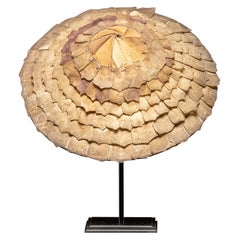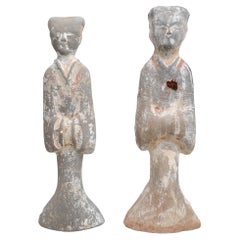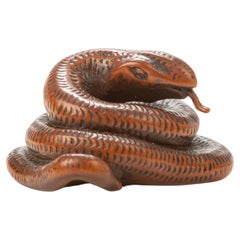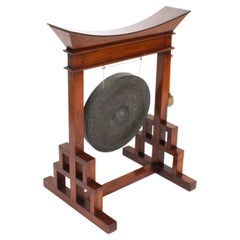Europe - Antiquities
to
66
426
881
424
2
4
2
2
2
2
1
1
1
1
1
93
148
183
2
66
35
63
22
1
11
7
3
8
5
8
17
2
155
111
83
71
52
363
287
150
130
27
426
426
426
4
3
2
1
1
Item Ships From: Europe
Ethnographic Fish Scale Hat Handmade Molucca, Indonesia.
Located in Leuven , BE
Ethnographic Fish Scale Hat Handmade Molucca, Indonesia.
Category
Early 20th Century Indonesian Europe - Antiquities
Materials
Animal Skin
Antique Terracotta Chinese Figures Statues
Located in Alessandria, Piemonte
Antique terracotta figures Han style from my private collection: collected about 35 years ago and never exibited to the public.
One is very ancient, the other one is more recent. The prices are different, but an expert can understand the value. A certificate Oxford test would be needed: I don't have it, so I'm accepting offers: I want to close my activities and I have a beautiful Chinese collection, see the other ones published under my name enrica pasino.
Category
15th Century and Earlier Chinese Han Antique Europe - Antiquities
Materials
Terracotta
$5,896 / set
A boxwood netsuke depicting a snake
Located in Milano, IT
Boxwood netsuke depicting a snake coiled around itself.
Signature engraved under the base.
Origin: Japan
Period: Meiji late 19th century.
Dimensions: 4 x 3.5 x 2 cm.
State of co...
Category
19th Century Japonisme Antique Europe - Antiquities
Materials
Boxwood
$1,698 Sale Price
20% Off
Nineteenth Century Chinese Metal Water Pipe, Covered with Green Dyed Ray Skin
Located in Leuven , BE
The Chinese water pipes for smoking opium or tobacco could be beautifully decorated with enamel or be coated with precious materials such as ray skin. How were they used? The heated opium was placed in the lidded well of the pipe. The smoker could inhale the fumes through this pipe. Most water pipes have a holder for storing the maintenance tools, such as a little brush, a spike and tweezers. The water pipes could easily be smoked while sitting down, unlike the regular opium pipes...
Category
19th Century Chinese Antique Europe - Antiquities
Materials
Metal
Prehistoric Stargazer Marble Head
Located in Vosselaar, BE
A small, Prehistoric Anatolian marble head of the kiliya type. Of highly stylized geometric form, the marble head is elliptical, with a faintly defined nos...
Category
15th Century and Earlier Turkish Prehistoric Antique Europe - Antiquities
Materials
Marble
Antique Aesthetic Movement Anglo Japanese Dinner Gong 19th Century
Located in London, GB
A superb quality Aesthetic Movement Anglo-Japanese dinner gong in the manner of Edward William Godwin, Circa 1880 in date.
This fabulous gong is...
Category
1880s Antique Europe - Antiquities
Materials
Other
Japanese silk jacket HAORI black with gold pattern
Located in Paris, FR
This is a silk jacket which was made in Japan.
It was made in Showa era around 1980s.
The haori is a traditional Japanese hip- or thigh-length jacket worn over a kimono. Resembling ...
Category
Late 20th Century Japanese Showa Europe - Antiquities
Materials
Silk
ANTIQUE SOLiD BRONZE JAPANESE KOI CARP STATUE OF A WONDERFULLY ELEGANT FISH
Located in West Sussex, Pulborough
Royal House Antiques
Royal House Antiques is delighted to offer for sale this absolutely stunning circa 1920 solid bronze Japanese Koi Carp statue
A wonderfully original find, this...
Category
Early 20th Century Japanese Japonisme Europe - Antiquities
Materials
Bronze
Japanese Antique Purple Haori Jacket with Silk, 1950s
Located in Paris, FR
This is a silk jacket which was made in Japan.
It was made in Showa era around 1950s.
The haori is a traditional Japanese jacket worn over a kimono. R...
Category
1950s Japanese Showa Vintage Europe - Antiquities
Materials
Silk
$264 Sale Price
20% Off
Japanese Wooden Dagger, Late 19th C
Located in Stockholm, SE
A Japanese high quality wooden dagger. The carving is made of the highest quality as often Japanese items are. There is a signature and a poem engraved on side. Comes from an old Swedish collection...
Category
Late 19th Century Japanese Edo Antique Europe - Antiquities
Materials
Boxwood
Japanese silk haori jacket black
Located in Paris, FR
This is a silk jacket which was made in Japan.
It was made in Showa era around 1990s.
This haori jacket has a family crest of MaruniChigaiTakanoHaMon.
The haori is a traditional Ja...
Category
Late 20th Century Japanese Showa Europe - Antiquities
Materials
Silk
Han Style Sandcolor Vase Table Lamp
Located in Vosselaar, BE
A Chinese Han style vase turned in to a tablelamp. Made from unglazed grey earthenware in a pot shape with subtle sandgrain patina. This vase has a grea...
Category
19th Century Chinese Han Antique Europe - Antiquities
Materials
Earthenware
Old Tibetan Conch Trumpet Horn
Located in Schellebelle, BE
Exceptional Old Tibetan Conch Shell Trumpet horn,
decorated with a Silver cover and semi-precious Stones Turquoise and Coral,
good old patina and w...
Category
1930s Tibetan Vintage Europe - Antiquities
Materials
Silver
Japanese silk jacket HAORI black with flower and lion pattern
Located in Paris, FR
This is a silk jacket which was made in Japan.
It was made in Showa era around 1980s.
The haori is a traditional Japanese hip- or thigh-length jacket worn over a kimono. Resembling ...
Category
Late 20th Century Japanese Showa Europe - Antiquities
Materials
Silk
"Blanc de Chine" Guanyin with Lotus Flower Porcelain, circa 1900
Located in Beuzevillette, FR
Porcelain "Blanc de Chine" Statuette of a Guanyin stand on a lotus leaf, holding a lotus flower.
China.
Early 20th century.
Category
Early 20th Century Chinese Chinoiserie Europe - Antiquities
A Japanese boxwood netsuke depicting a Dutchman with a child
Located in Milano, IT
Boxwood netsuke depicting a Dutchman with a child on his shoulder and a trumpet.
Excellent blond patina on the front contrasting with the darker part on the back.
Large himotoshi h...
Category
Mid-18th Century Japanese Japonisme Antique Europe - Antiquities
Materials
Boxwood
$3,773 Sale Price
20% Off
Antique Bronze Vase Cloisonné Japan Meiji 19th Century Japanese
Located in Amsterdam, Noord Holland
Absolute top Quality vase with superb decoration of flowers
Cloisonné is a way of enamelling an object, (typically made of copper) whereby fine wires are used to delineate the dec...
Category
19th Century Japanese Meiji Antique Europe - Antiquities
Materials
Porcelain
$1,413 Sale Price
20% Off
16th century stone architectural fragment
Located in Vosselaar, BE
A 16th century Spanish slate stone architectural fragment. Probably part of a commerative plaque. The Latin inscription only partly present but most likely being a religious referenc...
Category
16th Century Spanish Medieval Antique Europe - Antiquities
Materials
Slate
Japanese Half Kimono Belt Hanhaba Obi Orange with Embroidery 1980s
Located in Paris, FR
This is a Japanese beautiful Kimono belt called 'Han haba obi'.
Both side are with motifs but different motifs. It is a belt for kimono but you can use as a table runner or wall deco...
Category
1980s Japanese Showa Vintage Europe - Antiquities
Materials
Silk
Japan Satsuma Porcelain Vase and Golden Metal 19th Century
Located in Beuzevillette, FR
Large Satsuma porcelain vase from the Meiji on a gilt metal frame from the Napoleon III period. On one side of the vase is represented a deity, probably ...
Category
19th Century Meiji Antique Europe - Antiquities
Materials
Metal
Japanese Silk Jacket Michiyuki 1970s
Located in Paris, FR
This is a Japanese Silk Jacket called Michiyuki.
It was made around 1970s. This Michiyuki Jacket has a pocket and belts inside.
It is not reversi...
Category
1970s Japanese Showa Vintage Europe - Antiquities
Materials
Silk
Japanese Antique Kanzashi chrysantheme 1920s
Located in Paris, FR
This is a Japanese Kanzashi.
Kanzashi is a hair ornament used in traditional Japanese hairstyles.
These hair ornaments are made in about 1920s in Taisho era.
Two-piece stick-shaped...
Category
1920s Japanese Taisho Vintage Europe - Antiquities
Materials
Plastic
Japanese Paper Fan Sheep Heisei HOUSEN 1990s
Located in Paris, FR
This is a fan which was made in Japan around 1990s in Heisei era.
This is made with a paper and bamboos.
Japanese fans are made of paper on a bamboo frame, usually with a design pai...
Category
1990s Japanese Europe - Antiquities
Materials
Bamboo, Paper
Japanese Meiji Dressing Stand with Mirror Black Lacquer
By Vintage Japanese Monochrome
Located in Valladolid, ES
Elegant and beautiful Dressing Table or it could be suitable for a jewellery box , Meiji Period ( 1868 - 1912 ).
Executed with black lacquer, holding a bronze hand mirror ( ekagami)
Configured with five smooth-running drawers of different Size. Two are equipped with slender "hirute"-shaped bail handles and three with decorative pull-rings.
The front-and backside featuring oval grips for easy transport.
Surmounted by a mirror frame in a shape reminiscent of a Shintô shrine torii-gate-
a twin-posted framework with a triangular crossbar flared in upswept Chinese-style gable ( Karahafu) endings.
Resting of the frame is the Japanese traditional handheld mirror with auspicious embossed design of wisteria ( fuji) and lovely patina.
Inscription on the right.
Considering its age the set is in a very good condition with some traces of usage and wear conform age.
Dimensions:
Dressing stand...
Category
1880s Dutch Meiji Antique Europe - Antiquities
Materials
Bronze
$1,641 Sale Price
30% Off
Japanese silk haori jacket in blue-gray with flower and leaf pattern
Located in Paris, FR
This is a silk jacket which was made in Japan.
It was made in Showa era around 1980s.
The haori is a traditional Japanese hip- or thigh-length jacket worn over a kimono. Resembling ...
Category
Late 20th Century Japanese Showa Europe - Antiquities
Materials
Silk
Late 19th Century Bronze Chinese Buddha Sculpture
Located in Catania, Sicilia
An high quality bronze sculpture of Buddha hand-crafted in China in late 19th century. It has normal signs of use and age.
Category
Late 19th Century Chinese Chinese Export Antique Europe - Antiquities
Materials
Bronze
Japanese Antique Hanten "Onishiko" with Cotton showa (around 1960s)
Located in Paris, FR
Hanten is a type of traditional Japanese garment that is often referred to as a "short coat" or "jacket". `it has a loose, kimono-like design with a straight collar and is typically ...
Category
1960s Japanese Vintage Europe - Antiquities
Materials
Cotton
Antique Silk Japanese Kimono Belt, 1970s
Located in Paris, FR
This is a Hitoe Obi made in Japan around 1970s.
Obi is a belt of varying size and shape worn with both traditional Japanese clothing like Kimono....
Category
Late 20th Century Japanese Showa Europe - Antiquities
Materials
Silk
Pair of brown glazed ceramic elephants, garden stools or plant holders, China
Located in Beuzevillette, FR
Pretty pair of very decorative garden stools or plant stands or side tables in the shape of Asian elephants.
Hand painted ceramic.
The elephants are in ceremonial dress...
Category
Mid-20th Century Chinese Europe - Antiquities
Materials
Ceramic, Porcelain
Japanese silk jacket HAORI black with a white gold wave patterned lining
Located in Paris, FR
This is a silk jacket which was made in Japan.
It was made in Showa era around 1980s.
The haori is a traditional Japanese hip- or thigh-length jacket worn over a kimono. Resembling ...
Category
Late 20th Century Japanese Showa Europe - Antiquities
Materials
Silk
Japanese silk jacket HAORI black
Located in Paris, FR
This is a silk jacket which was made in Japan.
It was made in Showa era around 1980s.
The haori is a traditional Japanese hip- or thigh-length jacket worn over a kimono. Resembling ...
Category
Late 20th Century Japanese Showa Europe - Antiquities
Materials
Silk
Uzbekistan, Tajikistan: a Rare, Old ‘Bridal Crown’ 20th Century
Located in Madrid, ES
Uzbekistan, Tajikistan: a rare, old ‘bridal crown’ made of silver, gilded in parts, with turquoise coloured ornamental stones, glass, coral, and many pend...
Category
20th Century Uzbek Modern Europe - Antiquities
Materials
Silver
Chinese black green enamel flowers small water pipe opium pipe
By Dynasty Transorient
Located in Valladolid, ES
Amazing and beautiful Chinese cloisonné opium pipe, enamelled with loto flowers, character marks to the base, 28cm high
Astonishing opium pipe with mot...
Category
1890s Hong Kong Chinese Export Antique Europe - Antiquities
Materials
Bronze, Enamel
$669 Sale Price
34% Off
Three-drawer box of Chinese scope, late 19th century with floral decoration
Located in Vicenza, VI
hree-drawer box with closing panel of Chinese ambit, datable to the late 1800s.
The box is made of lacquered wood, on all sides there are plant and floral decorations, having as sub...
Category
Late 19th Century Chinese Chinese Export Antique Europe - Antiquities
Materials
Wood, Lacquer
Shokudai Candle Holders of Bronze from Japan, Meiji 1868-1912
Located in London, GB
Pair of Shokudai candle holders made of bronze during the Meiji period (1868-1912) in Japan. Includes original box as pictured.
Candle holders H. 66cm; diameter 26cm.
Lidded bro...
Category
Late 19th Century Japanese Meiji Antique Europe - Antiquities
Materials
Bronze
Late 19th Century Elmwood Console China Export
Located in Brescia, IT
This elegant elmwood console is handcrafted and so the beautiful details under the top and to the corners, both the sides. This is a piece of glamorous timeless
The top is in solid...
Category
Late 19th Century Chinese Chinese Export Antique Europe - Antiquities
Materials
Elm
$3,585 Sale Price
20% Off
Japanese white yukata with flower and wave pattern
Located in Paris, FR
This is a cotton jacket which was made in Japan in Showa era around 1980s.
A yukata (浴衣, lit. 'bathrobe') is an unlined cotton summer kimono, worn in casual settings such as summer ...
Category
Late 20th Century Japanese Showa Europe - Antiquities
Materials
Cotton
Japanese Spring Kimono Coat 'Michiyuki' Gray 1980s
Located in Paris, FR
This is a thin coat which we ware on the Kimono. It is for the spring.
This kind of coat is called Michiyuki in Japanese.
This coat was made in Japan around 1980s in Showa era.
Dim...
Category
1980s Japanese Showa Vintage Europe - Antiquities
Materials
Silk
Japanese white yukata with green flower and purple cross pattern
Located in Paris, FR
This is a cotton jacket which was made in Japan in Showa era around 1980s.
A yukata (浴衣, lit. 'bathrobe') is an unlined cotton summer kimono, worn in casual settings such as summer ...
Category
Late 20th Century Japanese Showa Europe - Antiquities
Materials
Polyester
Antique Chinese Opium Lamp with Round Base that is Multi-lobed
Located in Leuven , BE
Opium smokers used opium lamps to make the vaping and inhaling of the opium easier. These lamps, which contained spirits in their base, were specifically de...
Category
20th Century Chinese Europe - Antiquities
Materials
Brass
18th Century Chinese Sculpture of a Dignitary in Carved and Lacquered Hardwood
Located in Brescia, IT
Big hardwood figure of a dignitary lacquered in original patina. Signs of age-related wear on the base, but all of excellent quality, China, 18th century.
Category
18th Century Chinese Qing Antique Europe - Antiquities
Materials
Hardwood
19th Century Alter Table in Peach wood China
Located in Kastrup, DK
Small alter / communion table in peach wood from the Zhejiang Province of China. Original condition with red lacquer with age-related patina.
Ming sty...
Category
Mid-19th Century Chinese Ming Antique Europe - Antiquities
Materials
Wood
An Indian colonial tortoiseshell veneered teak portable two-door cabinet
Located in Amsterdam, NL
Mughal India, Gujarat, 2nd half 17th century
H. 22.4 x W. 30.3 x D. 26.8 cm
This small cabinet has six drawers behind two doors. Originally ordered by the Portuguese, and made afte...
Category
17th Century Indian Antique Europe - Antiquities
Materials
Tortoise Shell, Teak
Set Antique Oriental Cloisonné Graduated Containers, Early 20th Century
Located in Bishop's Stortford, Hertfordshire
A fine antique set oriental cloisonné graduated lidded containers of flattened rounded form each with a green foil leaf design to the cover with butterflies and leaf patterned design...
Category
Early 20th Century Chinese Europe - Antiquities
Materials
Copper
Japanese Silk Kimono Belt Fukuro-Obi 1970s /Table Runner
Located in Paris, FR
This is a Fukuro Obi made in Japan around 1970s.
It is made with Silk and it is in good condition.
Obi is a belt of varying size and shape worn with both traditional Japanese clothing like Kimono.Obi are categorised by their design, formality, material, and use, and can be made of a number of types of fabric, with heavy brocade weaves worn for formal occasions, and some lightweight silk obi worn for informal occasions.
Fukuro obi are slightly less formal than maru obi...
Category
Late 20th Century Japanese Showa Europe - Antiquities
Materials
Silk
$339 Sale Price
20% Off
18th Century Japanese Imari Gold Porcelain Small Lobbed Cups and Saucers
Located in Delft, NL
18th century Japanese Imari Gold porcelain small lobbed cups and saucers
Early 18th century imari gold lobbed Japanese cups and saucers
Small cups and saucers...
Category
Early 18th Century Japanese Antique Europe - Antiquities
Materials
Porcelain
19th Century Chinese Pair of Bronze Vases with Cloissoné Technique
Located in Marbella, ES
19th Century Chinese pair of bronze vases with Cloissoné Technique.
Category
Late 19th Century Chinese Antique Europe - Antiquities
Materials
Bronze
Antique Japanese Export Meiji High Relief Dragon Carved Throne Chair.
Located in Nantwich, GB
An impressive Imperial Meiji period Japanese throne chair which is finely and lavishly carved with dragons holding the eternal pearl in their mouths.
...
Category
Early 20th Century Japanese Meiji Europe - Antiquities
Materials
Wood
Japanese Silk Haori Jacket Black with White and Bleu Rose 1980s
Located in Paris, FR
This is a silk jacket which was made in Japan.
It was made in Showa era around 1980s.
The haori is a traditional Japanese hip- or thigh-length jacket worn over a kimono. Resembling ...
Category
1980s Japanese Showa Vintage Europe - Antiquities
Materials
Silk
Dutch Silver Plate Trinket Box Casket 1930 Hallmark
Located in Potters Bar, GB
Dutch silver plate trinket box and cover
Circa 1930
This pretty piece is embossed with figures and animals
We can ship to anywhere in the wor...
Category
1930s Vintage Europe - Antiquities
Materials
Silver Plate
Pair of Moon-Shaped Vases, China Late 19th Century
Located in Ixelles, BE
A pair of large moon-shaped "flasks" vases painted in blue and white, each flask decorated with scenes of active characters and surrounded by borders of floral motifs and foliate pat...
Category
Late 19th Century Chinese Antique Europe - Antiquities
Materials
Porcelain
$63,210 Sale Price / set
20% Off
16th-17th Century Chinese Pine Center Table with Carvings and Decorations
Located in Kastrup, DK
16th-17th century center table from 'Shanxi Province, China with 1 drawer.
Made of pine and with original polychrome lacquer.
Original condition. Rare piece of furniture.
Category
17th Century Chinese Ming Antique Europe - Antiquities
Materials
Elm
A boxwood netsuke depicting a peeled mandarin
Located in Milano, IT
A boxwood netsuke depicting a partially peeled mandarin, carved with extraordinary realism. The peel reveals the segmented interior of the fruit, with every detail carefully defined....
Category
Late 19th Century Japanese Antique Europe - Antiquities
Materials
Boxwood
$1,226 Sale Price
20% Off
Japanese Lacquer Suzuribako 硯箱 'Writing Box' by Hattori Toshio 服部俊夫 '1943'
By Hattori Toshio (Shunsho)
Located in Amsterdam, NL
A small Japanese black and gold lacquer suzuribako (writing box) with cartwheels in water, by the artist Hattori Toshio (1943).
Of rectangular form with rounded corners, bearing a lustrous rôiro ground throughout, the exterior sides of the box and exterior of the cover finely decorated in gold and little silver takamaki-e with cartwheels flowing in a dynamically executed body of water with many swirls
and gushes as well as scattered dew drops, the interior tray fitted with a rectangular ink stone and silver suiteki (waterdropper).
The underside signed ‘Toshi’.
With the original wooden tomobako with hakogaki reading Namikuruma makie suzuribako (The
writing box set, with a design of wheels in water), as well as a leaflet written in Japanese with the artist’s biography up to 1987.
Hattori Toshio (b. 1943), art name Hattori Shunsho, was first selected for the Nitten exhibition in Showa 38 (1963). Since then, he has exhibited more than twenty times at the Nitten and other exhibitions, winning numerous prestigious awards. In 1995,
he had an audience with Pope John Paul II and presented the Pope with a lacquer reading table. In 2004, he created the shelves for the guest room of the Kyoto State Guest House of the Government of Japan. He is a member of the Kyoto Crafts Artists Association, the Kyoto Lacquer...
Category
Late 20th Century Japanese Europe - Antiquities
Materials
Wood, Giltwood, Lacquer
Late 19th century Chinese pipe enhanced with plant decorations
Located in NANTES, FR
Late 19th century Chinese pipe enhanced with plant decorations
This Chinese pipe is old, it dates from the end of the 19th century and the beginning of the 20th century, it is beaut...
Category
Late 19th Century Asian Chinoiserie Antique Europe - Antiquities
Materials
Metal
Early 20th Century Chinese Tiger Eye Snuff Bottle
Located in Barcelona, ES
Early 20th century Chinese snuff bottle. Bottle and tap made out of tiger eye stone.
Category
Early 20th Century Chinese Europe - Antiquities
Materials
Agate
Louis XV Style Walnut Root Cabinet 19th Century
Located in Milano, IT
Splendid French writing cabinet from the Louis XV period from the 19th century.
The cabinet has four supporting feet with the pompous and majestic shapes of classic French furniture...
Category
Early 1800s French Empire Revival Antique Europe - Antiquities
Materials
Wood
$3,773 Sale Price
20% Off
Ancient Jain Altarpiece with Three Standing Jina's, Gujarat, India 16th Century
Located in Antwerp, BE
An authentic, ancient and exceptional Three Jina Shrine. For it’s age the altarpiece is in a very good condition and rather large. The image of three standing, nude Jinas flanked by the other 21 seated Jinas is rare. The lintel of the shrine is showing the nine comets and three seated figures...
Category
16th Century Indian Medieval Antique Europe - Antiquities
Materials
Bronze
$14,151 Sale Price
20% Off
Antique Japanese Meiji Period Set Of Cups or Tea Bowls Porcelain Landscape
Located in Amsterdam, Noord Holland
A very nice set of bowls with and lids. Very nicely decorated with a landscape scene.
They lids are marked.
Condition
1 of the lid has 2 or 3 small frits, rest perfect. Dishes perf...
Category
19th Century Japanese Meiji Antique Europe - Antiquities
Materials
Porcelain
Portuguese-colonial Japanese Namban lacquer Vargueno Cabinet, circa 1600
Located in Amsterdam, NL
A Portuguese-colonial Japanese Namban lacquer vargueno cabinet
Momoyama period, circa 1600
H. 43 x W. 64.5 x D. 36 cm
Wood, black lacquered and deco...
Category
Early 1600s Japanese Antique Europe - Antiquities
Materials
Gold, Brass
Recently Viewed
View AllMore Ways To Browse
Ichimatsu Doll
Jade Belt Hook
Japanese Spinning Wheel
Khmer Elephant
Tigers Eye Snuff Bottle
Bronze Bracelet Cambodia
Ichimatsu Ningyo Doll
Kimekomi Dolls
Luristan Bronze
Luristan Dagger
Monkey Gong
Pegu Bronze
Ruo Shen
Wheat Thrasher
11th Century Vishnu Stone Statue
Antique Cast Iron Hibachi
Dinosaur Statue
Han Dynasty Stick Man





